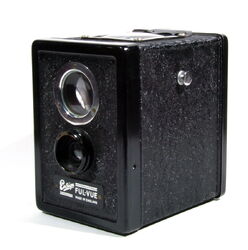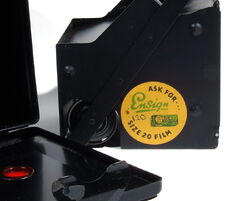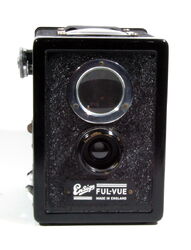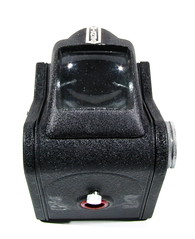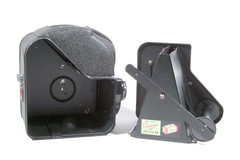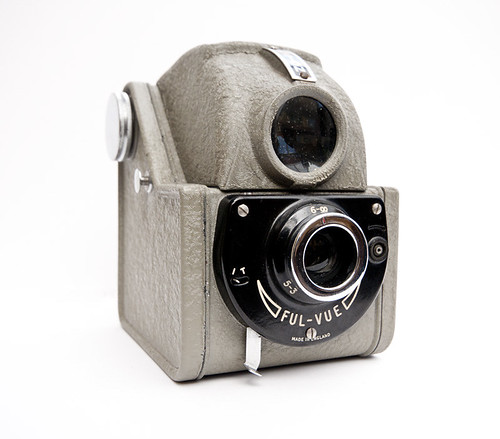
|
| Ensign Ful-Vue model II (1953) Coronation year model
Image by lovelykatherine (Image rights) |
cit: "The Ful-Vue camera is really a very simple camera. It consists of a light-tight box. In front of the box there is a hole, over which the lens is fixed. Behind this hole is the shutter. There is a second lens in a second box above it. This produces a picture on the viewfinder on top of the camera. In the back of the box is another hole covered by a red window. This helps you in winding the film on, which you do by the knob at the side of the box near the top." [Marcel Natkin].
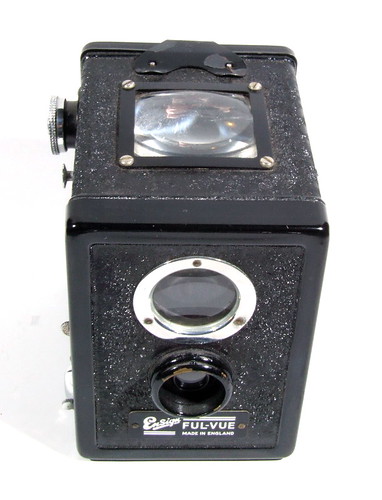
|
| Ful-Vue c.1946 (early Ful-Vue altered version)
Süleyman Demir (Image rights) |
The earliest Ful-Vue version of 1939 was a typical box camera with back door, but already having the characteristic big viewfinder. Like other box cameras it had a back door and an inner camera part which could be taken out of the box to load the film. In 1946 the camera was redesigned, getting away from average box camera design. Then the inner part of the camera was fixed to the side panel with the film winding knob. The whole unit could be pulled out of the camera sidewards after unlocking it with the knob on the other side panel.
Shutter speed was 1/30 sec. in instant mode and B in time mode. Focusing was possible by pulling the lens out for close exposures. Pictures were 6×6cm on 120 film.
In 1950 further improvements were made, the new flash synchronized shutter, the turnable lens barrel allowing three different distance settings instead of two, an all-plastic front panel, and an optional flashgun. The improved version was called Ful-Vue II. This was succeeded in 1954 by the Ross-Ensign Ful-vue Super, which had a flat front plate extending around both lenses, a cast alloy body (in place of the sheet steel) and a collapsible hood around the viewfinder. Its red window was closable. The film loading was eased another time by means of the removable back-and-bottom part which was held just by the clamp on the bottom. A more elegant flash unit was available, mountable without cable to a side panel of the camera.
Except for the Ful-Vue Super, which used 620 film the Ful-Vues use(d) type No. 120 rollfilm. An old Barnet-Ensign Ful-Vue may need some manipulation by simply bending the long metal strip that is part of the rollholder a little bit to achieve the necessary tension of the film. Using both rollfilm sizes in one Ful-Vue is not possible. The complete Ful-Vue series serves as a model for TTV cameras, cameras used for taking digital images through their amazingly big finders (through-the-viewfinder photography).
Ful-Vue timeline[]
| The history of the Ful-Vue reflects the history of the Ensign companies: | |||||
| Year | 1939-c.1943 | 1946-49 | 1950-53 | 1954-c.1959 | |
| Name | Ful-Vue (earliest) | Ful-Vue (early Ful-Vue altered version) | Ful-Vue Model II | Ful-Vue Super | |
| Maker | Ensign | Barnet Ensign | Barnet Ensign Ross | Ross-Ensign | |

|
| Early Ful-Vue (earliest version?) Image by Graustark (Image rights) |
Early Ful-Vue altered version specifications[]
- TLR like Box film camera (pseudo TLR), film: 120 roll, picture size:6x6cm
- Lens: meniscus filter slip-on
- Aperture: one, f/11
- Focus range: fixed focus, pull-out for close-up exposures
- Shutter: simple spring rotary shutter, one speed, Instant 1/30 and Time
- Cocking lever and Shutter release: by the same lever, for instant press once and release
- Viewfinder: waist level reflex brilliant finder, very big, on the top of the camera, the second lens like a finder lens of TLRs
- Winding knob: on the right side of the camera
- Flash PC socket: none
- Self-timer: none
- Back cover: hinged, opens by a latch on top of the camera
- Film loading: whole inner part of the camera could be pulled out after unlocking it with the winding knob on the other side panel
- Tripod socket: none
- Strap knobs
- Body: metal; Weight:
- Serial no.none
Ful-Vue Model II specifications[]
- TLR like Box film camera (pseudo TLR), film: 120 roll, picture size: 6x6cm
- Lens:Ensign Ensarmeniscus type, (lens name is not on the lens), fix aperture f/11, filter slip-on
- Focusing: manual front focusing, by pulling the lens out for close exposures; Three settings: feets 2 - 3-5 - 6 inf, markings behind the lens
- Shutter: Single-blade returning, safety pin shutter, one speed, Instant mode (I) 1/30, and Time mode (T); Setting: lever on the right of front plate, w/ I & T markings
- Cocking and Shutter release: by the same lever, on the bottom of the front plate, manual shutter cocking and releasing on the same time, by pressing once the lever, the diaphragm opens and closes
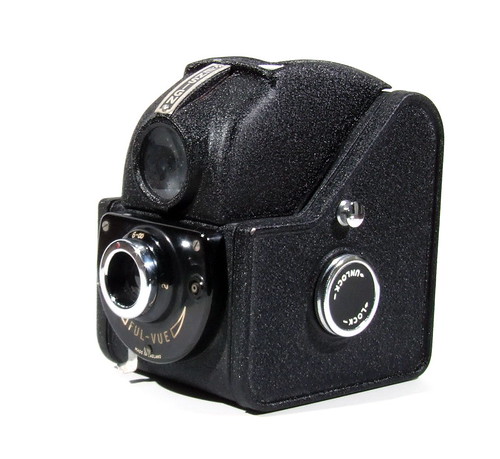
|
| Ensign Ful-Vue Model II (1950) Image by Süleyman Demir (Image rights) |
- Viewfinder: reflector type Waist level view finder, large and brilliant, Full View of the subject, (Ful-Vue), not actually mirrored glass but a polished metal plate
- Winding knob: on the right side of the camera
- Flash PC socket: on the left of the front plate
- Film loading: The whole unit for film loading could be pulled out of the camera right sidewards after unlocking it with the knob on the left side of the camera
- There is a sticker on the film loading part: Ask for Ensign 20 size film
- Red window: on the back side of the camera, w/buil-in lid, opens by the small knob over it
- Tripod socket: 1/4"
- Strap knobs
- Body: pressed steel, front plate (shutter housing) bakelite; Weight:
- Serial no.none
|
|
| ||||||
| Ensign Ful-Vue Model II (1950) Images by Süleyman Demir (Image rights) | ||||||||
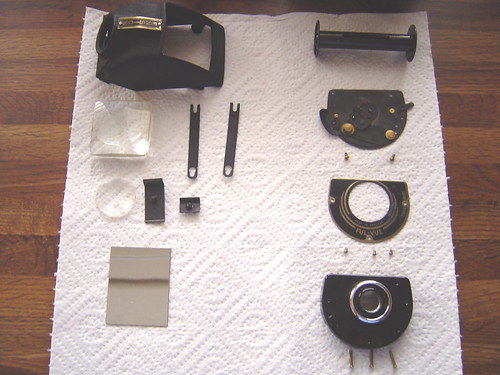
|
| Further disassembly of Barnet-Ensign Ful-Vue Image by fulvue(Image rights) |

|
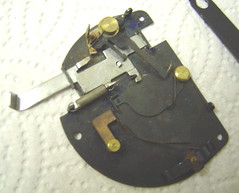
|

|
| Shutter of Barnet-Ensign Ful-Vue | Shutter of Ful-Vue II | |
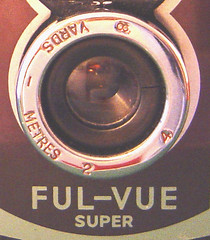
|
| Ful-Vue Super, distance scale Image by fulvue (Image rights) |
Links[]
- the Ful-Vue at www.ensign.demon [1]
- Full-Vue, Full-Vue, Full-Vue Synchro and Full-Vue and mode d'emploi at www.collection-appareils.com
- Flickr Group ful-vue with a lot of TTV images
- Ful-Vue at Living Image [2]
Literature[]
- Natkin, Marcel: Ful-Vue Guide. London and New York 1949 (2nd. edition 1951, 3rd ed. 1952., 4th ed. 1953)

